7 famous race cars you can buy at Le Mans in June
This year marks one full century since the first running of the 24 Hours Grand Prix of Endurance, aka the 24 Hours of Le Mans. The world’s most important sports-car race has some serious history behind it, and several pieces of that history will be up for grabs at an RM Sotheby’s auction held at the French circuit in conjunction with the race.
A small, curated group of 21 race cars (plus one very cool 1963 Ferrari safety car) will cross the block on June 9. Each is worth checking out, and all but one raced at Le Mans. Below are our favorites.
1996 Chrysler Viper GTS-R
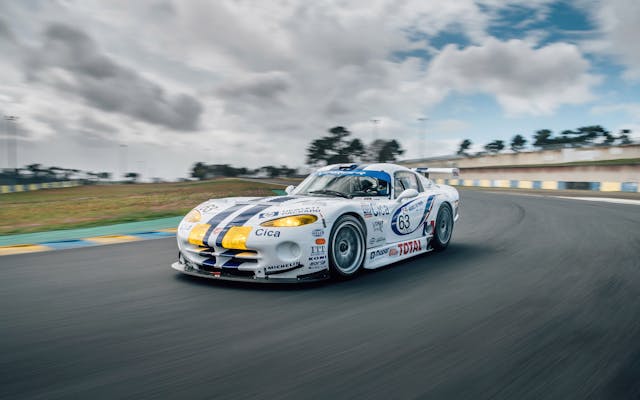
It wasn’t the first time American muscle made the trip to Le Mans, but Chrysler’s effort with the Viper was certainly one of the most successful.
Vipers took three class wins at Le Mans from 1998 to 2000, with the French team ORECA building and campaigning the cars. The first seven racing Vipers, however, were home-grown cars constructed by Chrysler in Detroit. This white and blue one is one of those Chrysler-built cars, and it ran its first race in 1997 for Viper Team Oreca at the 24 Hours of Daytona. After a 15th place finish there, it went to Le Mans with Justin Bell, John Morton, and Pierre Yver driving. That trio took it from 38th to 14th overall and fifth in class behind a quartet of Porsche 911 GT2s.
Before the 1998 season, it sold and was subsequently run in the British GT Championship, where it scored a handful of wins and helped secure the GT2 class championship. The year after that, it won a race in the Spanish GT Championship. Its last big performance was a class win at the 2008 Britcar Snetterton race, and its last competitive outing was at the 2008 Britcar 24 Hours of Silverstone, where it finished 5th in class.
Now, this piece of Viper Racing history has a €600,000–€700,000 ($650,000–$750,000) estimate. That’s not much compared to the seven-figure estimates of some of classics crossing the block in this sale, but if this GTS-R sells, it will become the most expensive Viper ever sold at auction. The current record holder is a 2017 ACR Voodoo II Edition sold for $418,000 earlier this year.
1991 Jaguar XJR-12 LM
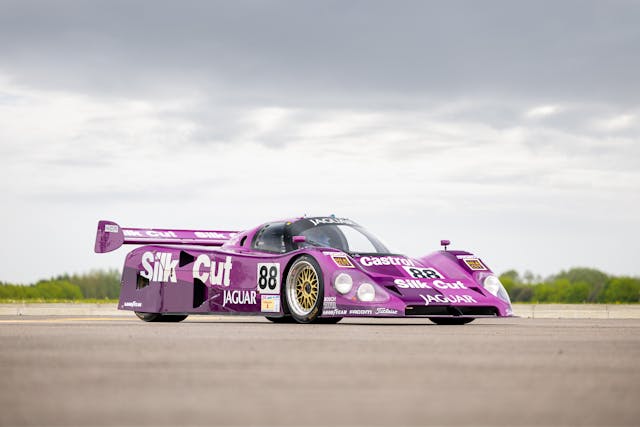
The 1990 Le Mans race saw Jaguar take its last win at the French classic. The XJR-12—with its monster 7.0-liter V-12, rear fender skirts, and flamboyant, purple and white Silk Cut cigarette livery—was the car with which the British marque did it. For 1991, the Group C formula that had defined sports car racing for the past decade was replaced, but older Group C machinery was still allowed to compete. Tom Walkinshaw Racing (TWR)/Jaguar ran the XJR-12 LM again, this time with an even larger 7.4 liter 12-banger.
This one ran the 24 Hours of Daytona and the 12 Hours of Sebring in 1991, finishing second and fourth, respectively. At Le Mans that year, Derek Warwick, John Nielsen, and Andy Wallace brought it home in fourth behind the winning Mazda 787B and the two other Silk Cut Jags.
Other Group C–era Jags that have crossed the auction block before include a Silverstone-winning 1990 XJR-11 that sold for £1,191,000 ($1,540,000) five years ago and a Daytona-winning 1988 XJR-9 that sold for €1,917,500 ($2,070,000) last year. This one could go even higher: It carries an estimate of €2,500,000–€3,000,000 ($2.7M–$3.2M).
1967 Alpine A210
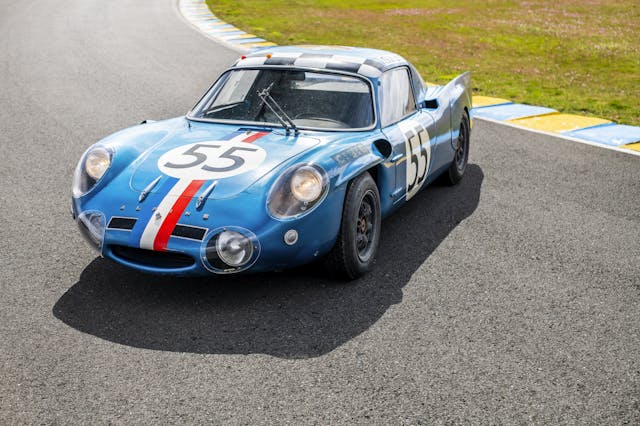
Known mostly for the rally-winning A110, the modern model of the same name, and its current Formula 1 team, Alpine (pronounced Al-peen) also has a long history in sports car racing. This car especially so—it’s a three-time Le Mans veteran.
Started by Jean Rédélé in 1955, the French firm had a Shell-sponsored race program going by 1962 and built steadily quicker pocket-rockets with Gordini/Renault power, lovely blue paint, and high rear fins. The A210 of 1966 followed the same formula, with a range of rear-mid-mounted, Gordini-tuned Renault twin-cam fours underneath the blue fiberglass bodywork. Only eight A210s were built, and this is arguably the most desirable of the bunch.
At Le Mans in 1967, it finished ninth overall and won its class with a 1.3-liter engine. It then finished seventh at Kyalami in South Africa with 1.5-liter power and in fourth at the Nürburgring 500km race in 1968. At Le Mans ’68 it won its class again, this time with a 1.0-liter engine, and won the Index of Performance—an award for efficiency that favored small (and, typically, French) cars. It returned to Le Mans in 1969 but sadly couldn’t pull off the hat trick, retiring after two hours with head-gasket failure.
Like many old race cars, this Alpine wound up unceremoniously stuffed into a shed, in this case for four decades. Pulled out in the 2010s, the dirt-covered racer sold for €872,800 ($949,800) at auction in 2016 and has since been cleaned up and mechanically sorted but not restored. Another A210 sold in 2015 for €476,800, but for the Le Mans auction this class-winner has a much higher estimate of €1,200,000–€1,500,000 ($1,300,000–$1,600,000).
1984 Lancia LC2
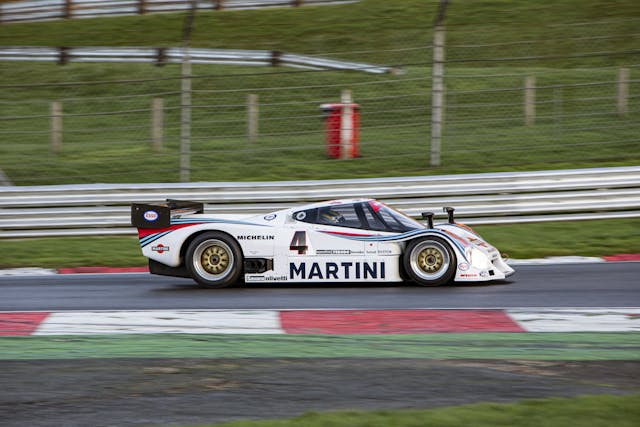
Like the Alpine, this Group C car is an endurance racer built by a company known for its rally cars.
Lancia withdrew from sports-car racing in the 1950s, but its rally success in the ’70s with the Fulvia and the Stratos encouraged the Italians to get back to the circuit. First came some class success with the Beta Monte Carlo silhouette racer (though it looked like a production car, the race version was significantly different on a mechanical level.) Then there was the spyder-bodied prototype LC1 designed by Gian Paolo Dallara. After a short competition life, it was replaced by the LC2.
The LC2 still featured a Dallara chassis, and its carbon fiber/Kevlar body was similarly shaped to that of the LC1, but now the race car had a roof. Lancia also ditched the LC1’s small, turbocharged four-cylinder for a Ferrari V-8. Based on the 32-valve engine from the 308 QV, the new mill was downsized to 2.65 liters and fitted with two KKK turbos.
The LC2s were always quick, but the reliability just wasn’t there, and on virtually every grid the Group C Lancias were far outnumbered by Porsches. At Le Mans in 1983, for example, there were three LC2s up against nine Porsche 956s. This one for sale took both pole and fastest lap at Le Mans in 1984, but couldn’t keep the pace and eventually finished eighth . . . behind seven Porsches.
It did, however, win the 1000-km race at Kyalami and found the podium at Silverstone. One of nine total LC2 chassis constructed for the 1983–86 World Sportscar Championship seasons, it has a €2,200,000–€2,400,000 ($2,350,000–$2,550,000) estimate for the Le Mans auction.
1936 Delahaye 135 S by Pourtout
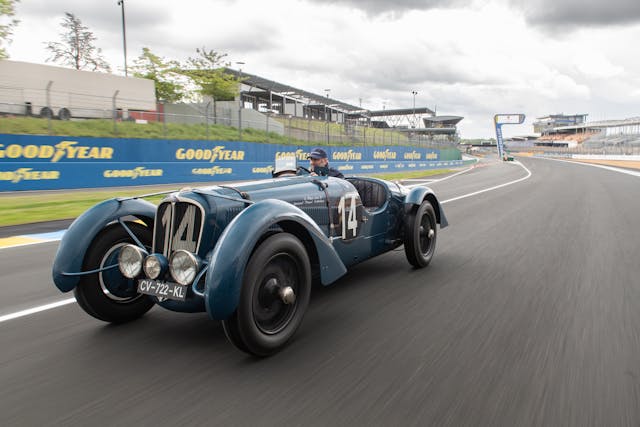
Built in 1936, this competition-spec Delahaye was entered in that year’s 24 Hours of Le Mans. Due to labor unrest, however, the organizers canceled the event that year. The car did finally get to Le Mans in 1938, and it finished second overall behind another 135-chassis Delahaye and ahead of a Talbot-Lago T150SS. Despite the German stranglehold on Grand Prix racing in the late 1930s, the home team still held its own at Le Mans. At the 1938 race, French cars, all driven by French drivers, took the first five places.
After the war, the Delahaye got a new, barchetta-type body in 1951 and raced at the 1954 Tour de France. In 1955 it was rebodied again as a cabriolet. From 2005–8, it received a full restoration to its period Le Mans specs, including a rebody in the correct Pourtout style. It has a €1,500,000–€2,000,000 ($1,600,000–$2,150,000) estimate.
1955 Ferrari 121 LM
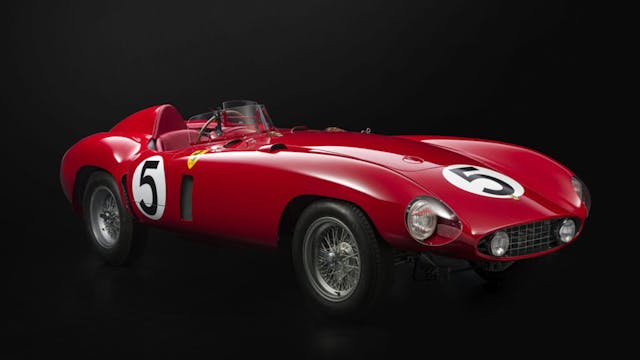
The 1955 Le Mans race is remembered for two things: Jaguar’s victory with its D-Type, and Pierre Levegh’s Mercedes launching into the grandstands and killing over 80 people. It was worst disaster in motorsports history.
This Ferrari was there, keeping pace with the eventual winner until it retired in the 10th hour with engine failure. It also ran at another famous race—the 1955 Mille Miglia—which saw Stirling Moss’s legendary performance in the winning Mercedes-Benz 300SLR. The Ferrari actually led that race for a time, but eventually suffered an oil pump failure. Sold at the end of the 1955 season, it raced in North America and underwent restoration from 2018 until earlier this year. One of just four Ferrari 121 LMs are left, this one sold in Monterey six years ago for $5.72M. For this trip across the auction block, it has an estimate of €5,500,000–€6,500,000 ($6,000,000–$7,000,000).
Works Ferrari race cars from the ’50s can be eight-figure cars, but a couple of things are keeping this car well below that threshold. First, the 121 LM is a straight six–powered car, which is generally less desirable than one with a V-12. Second, this chassis was involved in a fatal accident at the Pebble Beach Road Races in 1956.
1985 Porsche 962
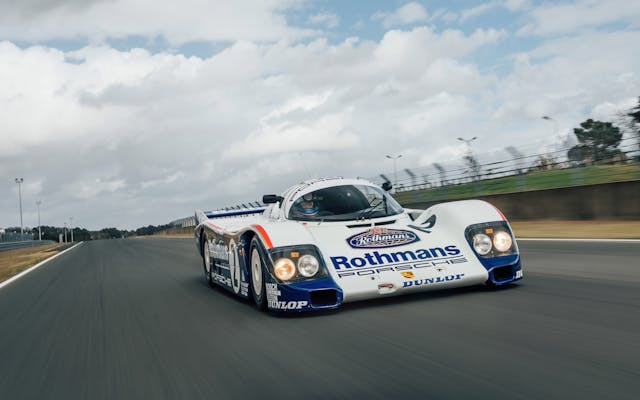
Campaigned by the Rothmans Porsche factory team in the 1985 and ’86 World Championship seasons, this 962 was driven in period by a who’s who of ’80s sports car racing: Derek Bell, Al Holbert, Jacky Ickx, Klaus Ludwig, Jochen Mass, Vern Schuppan, John Watson, and Hans Stuck.
It debuted at Le Mans in 1985, qualified fifth, and ran in second place behind a Porsche 956 for over 12 hours before this 962 suffered a crankshaft failure. At Le Mans the next year, it qualified on pole but retired. It then sold on to the factory-supported Joest Racing team and took second at the 1987 Nürburgring 1000 km. Over the course of its competition career it raced at Hockenheim, Mosport, Spa, Monza, Silverstone, and Kyalami—quite the resume.
Its predecessor, the Rothmans-sponsored 956 that won Le Mans in 1982, sold for $10.12M back in 2016, but without a win at La Sarthe to its credit, this 962 has a presale estimate of “only” €6,000,000–€9,000,000 ($6,500,000–$9,500,000).
***
Check out the Hagerty Media homepage so you don’t miss a single story, or better yet, bookmark it. To get our best stories delivered right to your inbox, subscribe to our newsletters.
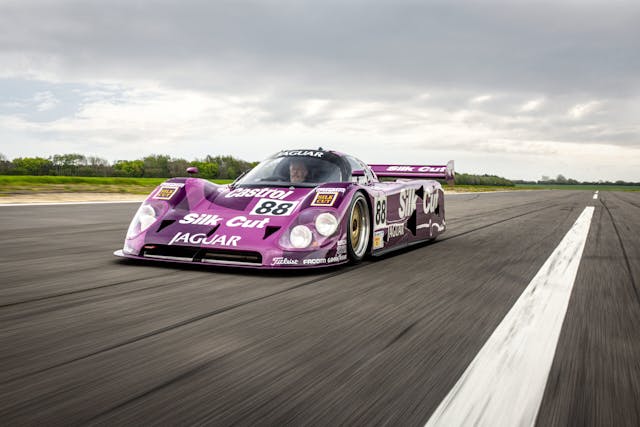


I’ll take the Ferrari, the Silk Cut Jaguar, and the Porsche 962!
Duplicate article, duplicate post. I like the purple silk cut Jag.